Properties, Procedure Steps, Example Solved Problems | Statistics - StudentŌĆÖs t Distribution and Its Applications | 12th Statistics : Chapter 2 : Tests Based on Sampling Distributions I
Chapter: 12th Statistics : Chapter 2 : Tests Based on Sampling Distributions I
StudentŌĆÖs t Distribution and Its Applications
STUDENTŌĆÖS t DISTRIBUTION AND ITS APPLICATIONS
1. StudentŌĆÖs t-distribution
If X~N(0,1) and Y~Žćn2
are independent random variables, then

is said to have t-distribution with n degrees of
freedom. This can be denoted by tn.
Note 1: The degrees of freedom of t is the same as the degrees of freedom of the
corresponding chi-square random variable.
Note 2: The t-distribution is used as the sampling distribution(s) of the
statistics(s) defined based on random sample(s) drawn from normal
population(s).
(i) If X1, X2 , ŌĆ”, Xn
is a random sample drawn from N (╬╝, Žā2)
population then
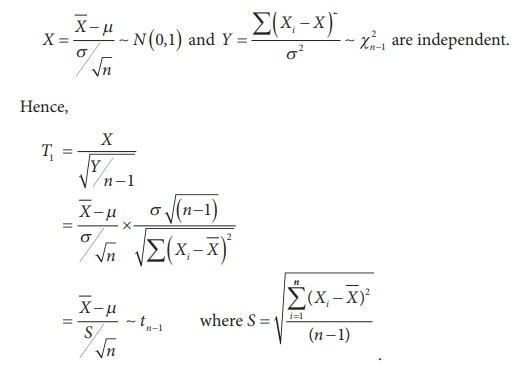
(ii) If (X1 , X2 , ŌĆ”, Xm) and (Y1 , Y2 , ŌĆ”, Yn) are independent random samples drawn from N (╬╝X , Žā2) and N (╬╝Y , Žā2) populations respectively, then

(iii) If (X1 , Y1), (X2 , Y2), ŌĆ”, (Xn , Yn) is a random sample of n paired observations drawn from a bivariate normal population, then Di = Xi ŌĆō Yi , i = 1, 2, ŌĆ”, n is a random sample drawn from N (╬╝D , ŽāD2). Here ╬╝D = ╬╝X ŌĆō ╬╝Y.
Hence,

2. Properties of the StudentŌĆÖs t-distribution
1. tŌĆōdistribution is
symmetrical distribution with mean zero.
2. The graph of t-distribution is similar
to normal distribution except for the following two reasons:
(i) The normal distribution curve is higher in
the middle than t-distribution curve.
(ii) tŌĆōdistribution has a
greater spread sideways than the normal distribution curve. It means
that there is more area in the tails of t-distribution.
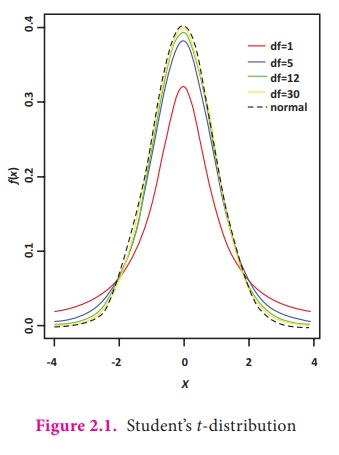
3. The t-distribution curve is asymptotic
to X-axis, that is, it extends to infinity on either side.
4. The shape of t-distribution curve
varies with the degrees of freedom. The larger is the number of degrees of
freedom, closeness of its shape to standard normal distribution (fig. 2.1).
5. Sampling distribution of t does not depend on population parameter. It depends on degrees of freedom (nŌĆō1).
3. Applications of t-distribution
The t-distribution has the following important applications
in testing the hypotheses for small samples.
1. To test significance of a single population mean, when
population variance is unknown, using T1.
2. To test the equality of two population means when population
variances are equal and unknown, using T2.
3. To test the equality of two means ŌĆō paired t-test, based
on dependent samples, T3.
4. Test of Hypotheses for Normal Population Mean (Population Variance is Unknown)
Procedure:
Step 1 : Let ┬Ą and Žā2 be
respectively the mean and variance of the population under study, where Žā2
is unknown. If ┬Ą0 is an admissible value of ┬Ą,
then frame the null hypothesis as
H0: ┬Ą = ┬Ą0 and choose the suitable
alternative hypothesis from
(i) H1: ┬Ą ŌēĀ ┬Ą0 (ii) H1:
┬Ą > ┬Ą0 (iii) H1: ┬Ą < ┬Ą0
Step 2 : Describe the sample/data and its descriptive measures. Let ( X1,
X2, ŌĆ”, Xn) be a random sample
of n observations drawn from the population, where n is small (n
< 30).
Step 3 : Specify the level of significance, ╬▒.
Step 4 : Consider the test statistic  , under
H0, where
, under
H0, where ![]() and
S are the sample mean and sample
standard deviation respectively. The approximate sampling distribution of the test
statistic under H0 is the t-distribution with (nŌĆō1) degrees of freedom.
and
S are the sample mean and sample
standard deviation respectively. The approximate sampling distribution of the test
statistic under H0 is the t-distribution with (nŌĆō1) degrees of freedom.
Step 5 : Calculate the value of t
for the given sample ( x1 , x2 ,... xn ) as  .
here
.
here ![]() is the sample mean and s =
is the sample mean and s =  is the sample standard
deviation.
is the sample standard
deviation.
Step 6 : Choose the critical value, te,
corresponding to ╬▒ and H1 from
the following table

Step 7 : Decide on H0 choosing the suitable
rejection rule from the following table corresponding to H1.

Example 2.1
The average monthly sales, based on past experience of a
particular brand of tooth paste in departmental stores is Ōé╣ 200. An
advertisement campaign was made by the company and then a sample of 26
departmental stores was taken at random and found that the average sales of the
particular brand of tooth paste is Ōé╣ 216 with a standard deviation of Ōé╣8. Does the campaign have helped in promoting
the sales of a particular brand of tooth paste?
Solution:
Step 1 : Hypotheses
Null Hypothesis H0: ┬Ą = 200
i.e., the average monthly sales of a particular brand of tooth paste is
not significantly different from Ōé╣ 200.
Alternative Hypothesis H1: ┬Ą > 200
i.e., the average monthly sales of a particular brand of tooth paste are
significantly different from Ōé╣ 200. It is one-sided (right) alternative
hypothesis.
Step 2 : Data
The given sample information are:
Size of the sample (n) = 26. Hence, it is a small sample.
Sample mean ( ![]() ) = 216, Standard deviation of the
sample = 8.
) = 216, Standard deviation of the
sample = 8.
Step 3 : Level of significance
╬▒ = 5%
Step 4 : Test statistic
The test statistic under H0
is T = 
Since n is small, the sampling distribution of T is
the t-distribution with (nŌĆō1) degrees of freedom.
Step 5 : Calculation of test statistic
The value of T for the given sample information is
calculated from

Step 6 : Critical value
Since H1 is one-sided (right) alternative
hypothesis, the critical value at ╬▒ =0.05 is
te = tn-1, ╬▒ =t25,0.05 = 1.708
Step 7 : Decision
Since it is right-tailed test, elements of critical region are
defined by the rejection rule t0 >te = tn-1, ╬▒
= t25,0.05 = 1.708. For the given sample information t0 =
10.20 > te =1.708. It indicates that given sample contains
sufficient evidence to reject H0. Hence, the campaign has
helped in promoting the increase in sales of a particular brand of tooth paste.
Example 2.2
A sample of 10 students from a school was selected. Their scores
in a particular subject are 72, 82, 96, 85, 84, 75, 76, 93, 94 and 93. Can we
support the claim that the class average scores is 90?
Solution:
Step 1 : Hypotheses
Null Hypothesis H0: ┬Ą = 90
i.e., the class average scores is not significantly different from 90.
Alternative Hypothesis H1 : ┬Ą ŌēĀ 90
i.e., the class means scores is significantly different from 90.
It is a two-sided alternative hypothesis.
Step 2 : Data
The given sample information are
Size of the sample (n) = 10. Hence, it is a small sample.
Step 3 : Level of significance
╬▒= 5%
Step 4 : Test statistic
The test statistic under H0
is T = 
Since n is small, the sampling distribution of T is
the t - distribution with (nŌĆō1) degrees of freedom.
Step 5 : Calculation of test statistic
The value of T for the given sample information is
calculated from t0 =  as under:
as under:
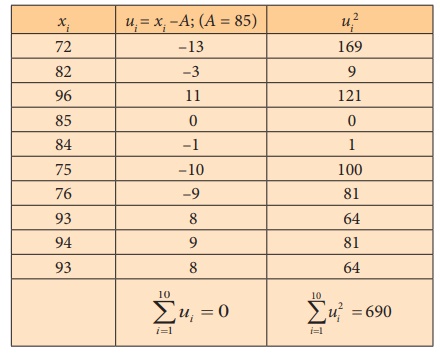
Sample mean
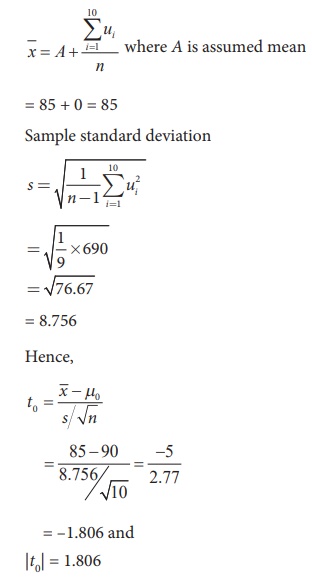
Step 6 : Critical value
Since H1
is two-sided alternative hypothesis, the critical value at ╬▒ = 0.05 is te = tn-1,
╬▒/2 = t9,0.025 = 2.262
Step 7 : Decision
Since it is two-tailed test, elements of critical region are
defined by the rejection rule |t0| > te = t n-1, ╬▒/2 = t =2.262. For the given sample information |t0| =
1.806 < te = 2.262.
It indicates that given sample does not provide sufficient evidence to reject H0. Hence, we conclude that the class average scores is 90.
5. Test of Hypotheses for Equality of Means of Two Normal Populations (Independent Random Samples)
Procedure:
Step 1 : Let ╬╝X and ╬╝Y
be respectively the means of population-1 and population-2 under study. The
variances of the population-1 and population-2 are assumed to be equal and
unknown given by Žā2.
Frame the null hypothesis as H0 : ┬ĄX = ┬ĄY
and choose the suitable alternative hypothesis from (i) H1 : ╬╝X
ŌēĀ ╬╝Y (ii) H1 :
╬╝X > ╬╝Y (iii) H1
: ╬╝X < ╬╝Y
Step 2 : Describe the sample/data. Let (X1, X2 , ŌĆ”, Xm)
be a random sample of m observations drawn from Population-1 and (Y1,
Y2 , ŌĆ”, Yn) be a random sample of n observations drawn
from Population-2, where m and n are small (i.e., m < 30 and n < 30).
Here, these two samples are assumed to be independent.
Step 3 : Set up level of significance (╬▒)
Step 4 : Consider the test statistic

where
Sp is the ŌĆ£pooledŌĆØ
standard deviation (combined standard deviation) given by
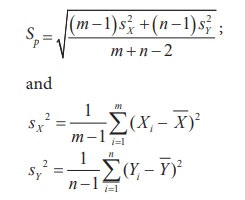
The
approximate sampling distribution of the test statistic

is the t-distribution with m+nŌĆō2 degrees of freedom i.e., t ~ tm+nŌĆō2.
Step 5 : Calculate the value of T for the given sample
( x1 , x2 ,...
xm ) and ( y1 , y 2
,... yn ) as

Step 6 : Choose the critical value, te,
corresponding to ╬▒ and H1 from
the following table

Step 7 : Decide on H0 choosing the suitable
rejection rule from the following table corresponding to H1.

Example 2.3
The following table gives the scores (out of 15) of two batches of
students in an examination.

Test at 1% level of significance the average performance of the
students in Batch I and Batch II are equal.
Solution:
Step 1 : Hypotheses: Let ┬ĄX and ┬ĄY denote respectively the average performance of
students in Batch I and Batch II. Then the null and alternative
hypotheses are :
Null Hypothesis H0 : ┬Ą X = ┬ĄY
i.e., the average performance of the students in Batch I and Batch II
are equal.
Alternative Hypothesis H1 : ┬Ą X ŌēĀ ┬ĄY
i.e., the average performance of the students in Batch I and Batch II
are not equal.
Step 2 : Data
The given sample information are:
Sample size for Batch I : m =10
Sample size for Batch II : n = 8
Step 3 : Level of significance
╬▒= 1%
Step 4 : Test statistic
The test statistic under H0 is

The sampling distribution of T under H0
is the t-distribution with m+nŌĆō2 degrees of freedom i.e.,
t ~ tm+nŌĆō2
Step 5 : Calculation of test statistic
To find sample mean and sample standard deviation:

To find sample means:
Let (x1 , x2 ,..., x10)
and (y1, y2 ,..., y8)
denote the scores of students in Batch I and Batch II respectively.
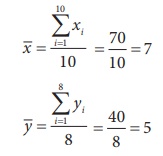
To find combined sample standard deviation:
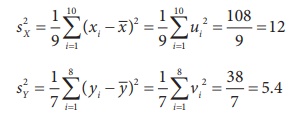
Pooled
standard deviation is:

The
value of T is calculated for the given information as

Step 6 : Critical value
Since H1 is two-sided alternative hypothesis,
the critical value at ╬▒ = 0.01 is te = tm+n-2, ╬▒/2 = t16,0.005
= 2.921
Step 7 : Decision
Since it is two-tailed test, elements of critical region are
defined by the rejection rule
|t0| < te =
tm+n-2, ╬▒ = t16,0.005 =
2.921. For the given sample information |t0| = 1.3957 < te
= 2.921.
It indicates that2 given sample contains insufficient
evidence to reject H0. Hence, the mean performance of the
students in these batches are equal.
Example 2.4
Two types of batteries are tested for their length of life (in
hours). The following data is the summary descriptive statistics.

Is there any significant difference between the average life of
the two batteries at 5% level of significance?
Solution:
Step 1 : Hypotheses
Null Hypothesis H0 : ╬╝X = ╬╝Y
i.e., there is no significant difference in average life of two types of
batteries A and B.
Alternative Hypothesis H0 : ╬╝X ŌēĀ ╬╝Y
i.e., there is significant difference in average life of two types of
batteries A and B. It is a two-sided alternative hypothesis
Step 2 : Data
The given sample information are :
m = number of batteries under type A = 14
n = number of batteries under type B = 13
![]() =
Average life (in hours) of type A battery = 94
=
Average life (in hours) of type A battery = 94
![]() = Average life (in hours) of type B battery = 86
= Average life (in hours) of type B battery = 86
sX = standard deviation of type A battery =16
sY = standard deviation of type B battery = 20
Step 3 : Level of significance
╬▒= 5%
Step 4 : Test statistic
The test statistic under H0 is

The sampling distribution of T under H0
is the t-distribution with m+nŌĆō2 degrees of freedom i.e.,
t ~ tm+nŌĆō2
Step 5 : Calculation of test statistic
Under null hypotheses H0:

where
s is the pooled standard deviation given by,

The
value of T is calculated for the given information as

Step 6 : Critical value
Since H1 is two-sided alternative hypothesis, the
critical value at ╬▒ = 0.05 is te = tm+n-2, ╬▒/2 = t25,
0.025 = 2.060.
Step 7 : Decision
Since it is a two-tailed test, elements of critical region are
defined by the rejection rule |t0| < te = tm+n-2,╬▒/2
= t25, 0.025 = 2.060. For the given sample information |t0|
= 1.15 < te = 2.060. It indicates that2 given sample contains
insufficient evidence to reject H0. Hence, there is no significant difference
between the average life of the two types of batteries.
6. To test the equality of two means ŌĆō paired t-test
Procedure:
Step 1 : Let X and Y be two
correlated random variables having the distributions respectively N(╬╝X
, ŽāX2) (Population-1) and N(╬╝Y
, ŽāY2) (Population-2). Let D = XŌĆōY,
then it has normal distribution N(╬╝D = ╬╝X
ŌĆō ╬╝Y, ŽāD2).
Frame null hypothesis as
H0 : ╬╝D= 0
And choose alternative hypothesis from
(i) H1 : ╬╝DŌēĀ
0 (ii) H1 : ╬╝D> 0 (iii) H1
: ╬╝D< 0
Step 2 : Describe the sample/data. Let (X1, X2,
ŌĆ”, Xm) be a random sample of m observations
drawn from Population-1 and (Y1, Y2,
ŌĆ”, Yn) be a random sample of n observations drawn from
Population-2. Here, these two samples are correlated in pairs.
Step 3 : Set up level of significance (╬▒)
Step 4 : Consider the test statistic
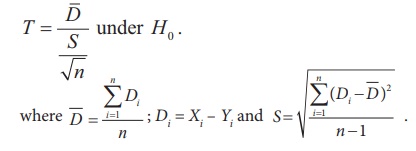
The approximate sampling distribution of the test statistic T
under H0 is t - distribution with (nŌĆō1) degrees
of freedom.
Step 5 : Calculate the value of T for the given data
as
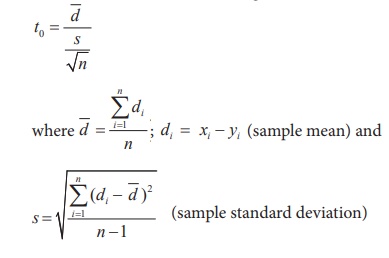
Step 6 : Choose the critical value, te,
corresponding to ╬▒ and H1 from
the following table

Step 7 : Decideon H0 choosing the suitable
rejection rule from the following table corresponding to H1.

Example 2.5
A company gave an intensive training to its salesmen to increase
the sales. A random sample of 10 salesmen was selected and the value (in lakhs
of Rupees) of their sales per month, made before and after the training is
recorded in the following table. Test whether there is any increase in mean
sales at 5% level of significance.

Solution:
Step 1 : Hypotheses
Null Hypothesis H0 : ╬╝D= 0
i.e., there is no significant increase in the mean sales after the
training.
Alternative Hypothesis H1 : ╬╝D> 0
i.e., there is significant increase in the mean sales after the
training. It is a one-sided alternative hypothesis.
Step 2 : Data
Sample size n = 10
Step 3 : Level of significance
╬▒= 5%
Step 4 : Test statistic
Test statistic under the null hypothesis is

The sampling distribution of T under H0
is t - distribution with (10ŌĆō1) = 9 degrees of freedom.
Step 5 : Calculation of test statistic
To find ![]() and s:
and s:
Let x denote sales before training and y denote
sales after training
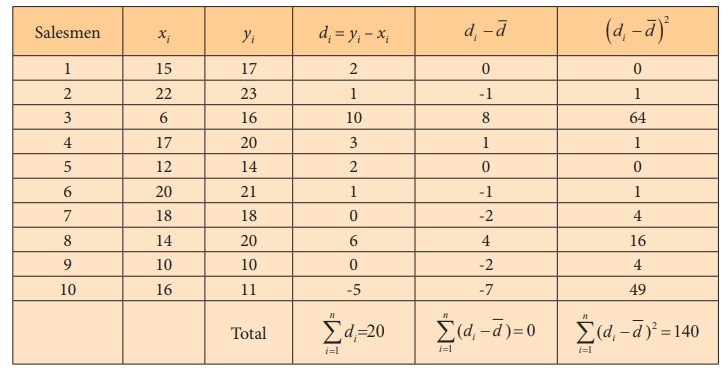
Here instead of di = xi ŌĆō yi it is assumed di = yi ŌĆō xi for calculations to be simpler.
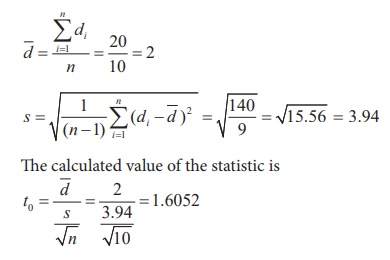
Step 6 : Critical value
Since H0 is a one-sided alternative hypothesis,
the critical value at 5% level of significance is te = tn-1,
╬▒ =t9,0.05 = 1.833
Step 7 : Decision
It is a one-tailed test. Since |t0| = 1.6052
< te = tn-1, ╬▒
= t9,0.05 = 1.833, H0 is
not rejected.
Hence, there is no evidence that the mean sales has increased
after the training.
Related Topics